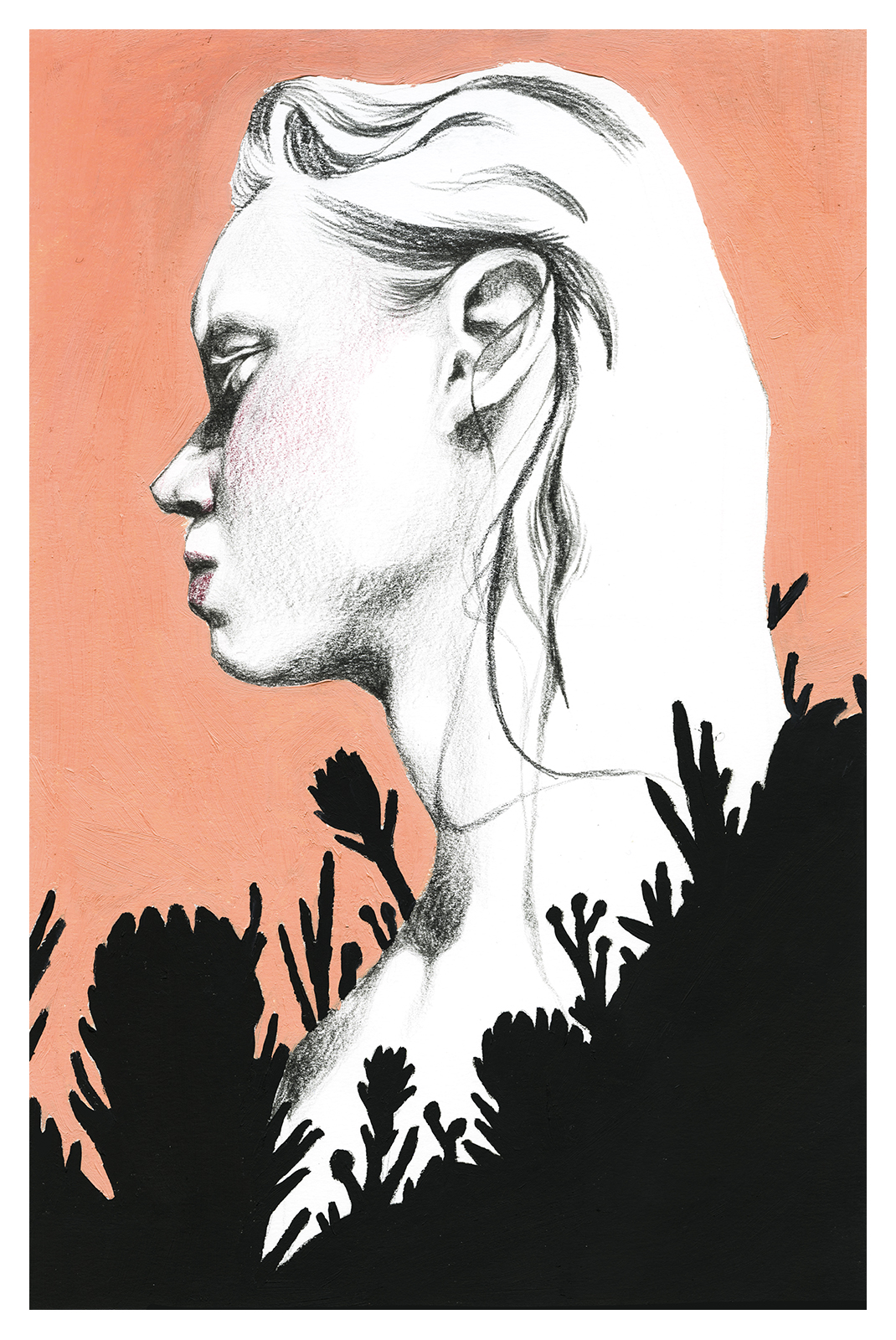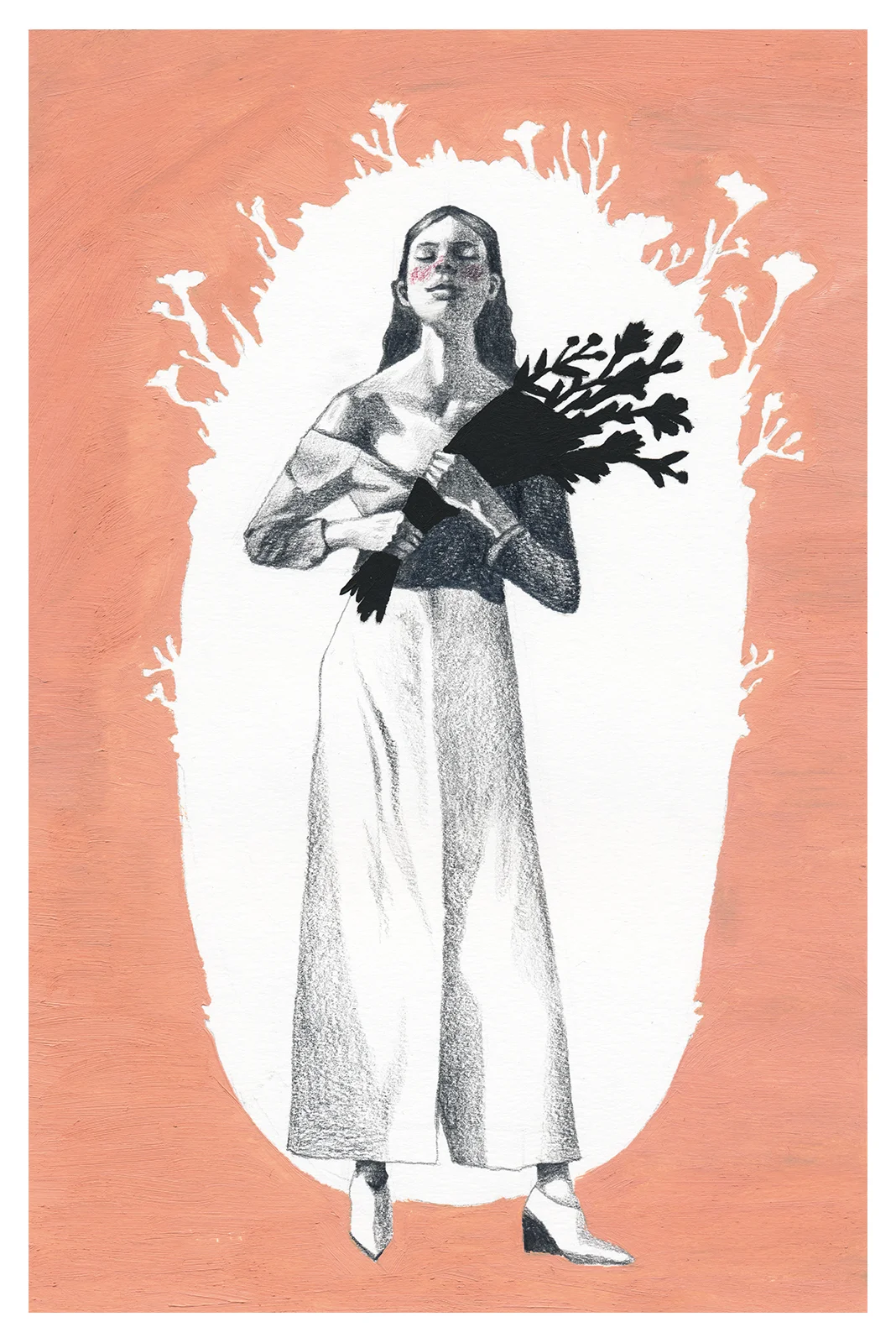ŠPELA SENICA
DOREJA
IZ NAŠE SPLETNE TRGOVINE
BIOGRAFIJA
BIOGRAPHY
“Sem Špela Senica, rojena v Mariboru leta 1999. Zaključila sem Srednjo šolo za oblikovanje Maribor, smer grafično oblikovanje. Trenutno obiskujem prvi letnik Kunstuniverzität v Linzu, smer grafično oblikovanje in fotografija. Rišem že od malega, ko sem opazovala ustvarjati svojega dedka, karikaturista Draga Senico. To je tudi spodbudilo mojo ustvarjalno pot, saj sem v risanju našla veselje. Ker me zanimajo različni mediji, pristopi, tehnike ipd., se pogosto znajdem na različnih delavnicah, tečajih, kjer se učim novih veščin. Trenutno se najbolj posvečam študiju in pridobivanju novih znanj ter izkušenj, ki mi bodo prišle prav pri nadaljnjem ustvarjanju, saj za zdaj še ne želim ustvarjati v slogu, ki bi me definiral. Veliko več mi v tem trenutku pomeni odkrivanje novih medijev, eksperimentiranje... Vseeno pa je nekaj mojih del le pokukalo na svet in bo zdaj na ogled javnosti.”
Špela je študentka prvega letnika, njena avtentičnost in nadarjenost pa dokazujeta, da je z ustvarjanjem povezana vse do malih nog. Iz Maribora se je odpravila na študij v Linz, kjer pravi, da jo mikajo raznoliki mediji, kar odseva tudi v seriji slik Doreja, narejeni posebej za dotično razstavo. Pravi, da jo je za serijo navdihnil naš večni Prešeren, saj bo razstava objavljena točno na praznik kulture.
Podobe so navezane na žensko esenco in like, med katerimi se znajdejo tudi portreti. Rdeča nit se tukaj pravzaprav spremeni v »rožnato nit«, kajti ravno rožnata povezuje skorajda vsa dela in tako dopolnjuje risarsko veščino svinčnika, v katerem so narisane glavne upodobitve. Avtorica svinčnik dopolnjuje s širokimi in vidnimi potezami akrilnih barv. Če risarske poteze delujejo elegantno, premišljeno in nežno, poteze širokega čopiča, nežni barvi navkljub, najavljajo nekoliko bolj udarnejšo, močnejšo žensko plat, ki jo dopolnjujejo črne silhuetne forme.
Čeprav je Špela Senica še na začetku svoje umetniške poti, izpričuje močne korake v lasten umetniški slog, mi pa ji na njeni poti vsekakor želimo vse dobro!
“I am Špela Senica, born in Maribor in 1999. I graduated from the Secondary School for Design Maribor in graphic design. I am currently attending the first year of the Kunstuniverzität Linz, the course for graphic design and photography. I’ve been drawing since I was little, after I observed my grandfather, caricaturist Drago Senica, creating art. This has also inspired my creative path, since I’ve found joy in drawing. Since I’m interested in different media, approaches, techniques, etc., I frequently find myself at different workshops, classes, where I acquire new skills. Currently, I focus mainly on studying and gaining new knowledge and experience that can be useful in my creative process in the future, since I don’t want to create in a style that defines me. At the present, discovering new media and experimenting means much more to me … Although now, a few of my works have seen the light of day and are on display for the public.”
Špela is a first-year student, and her authenticity and talent prove her connection with creativity since her young age. She left Maribor to study in Linz, where she is interested in diverse media, she says. This is also reflecting in the series of Doreja paintings, made especially for this exhibition. She says that for this series she was inspired by Slovenian eternal poet Prešeren, and the exhibition will be published exactly on the Prešeren Day, the Slovene Cultural Holyday.
Images are related to women's essence and figures, including portraits. Here the main theme turns into pink, because it is exactly the colour pink that connects virtually all the works, while complementing the pencil drawing skills with which the main depictions are drawn. The author complements the pencil with wide and visible strokes of acrylic paint. While the drawing strokes look elegant, thoughtful and gentle, the wide-brush strokes, despite tender colours, announce a slightly more powerful, stronger female side, complemented by black silhouette forms.
Although Špela Senica is still at the beginning of her artistic journey, she shows a strong course into her own artistic style, and we all definitely wish her the very best on her path!
POGOVOR Z AVTORJEM
Špela, v letošnjem študijskem letu si začela s študijem v tujini. Tisti, ki ti sledimo na Instagramu, vidimo, da imate študenti v Linzu možnost ustvarjati tudi v galeriji. Zakaj si se odločila za Linz; kje si videla prednosti v primerjavi z ljubljansko Akademijo, na katero si bila prav tako sprejeta?
Že nekako po končani srednji šoli sem vedela, da bi si želela iti v tujino ter poskusiti nekaj novega. Sprva nisem želela iti daleč in sem odkrila Kunstuniverzität v Linzu, kjer sem na dnevu odprtih vrat spoznala, da bi bila to super odskočna deska. Pritegnilo me vzdušje in interes profesorjev, da bi delili znanje z mladimi, ki ga v Sloveniji mogoče nisem našla v tolikšni meri. Ne bi rekla, da pri nas tega ni, saj sama nimam osebnih izkušenj s tovrstno šolo pri nas. Odločitev za Linz bila tako čisto stvar občutka in možnosti širine izobrazbe, ki mi je bila ponujena.
Omenjaš, da se že od malega ukvarjaš z risanjem, na tvoje veselje do ustvarjalnosti pa je vplival tudi dedek, Drago Senica, priznani karikaturist. Sta kdaj ustvarjala skupaj, te je prav on spodbujal na umetniški poti?
Res je, da rišem že od malega iz svojega veselja, in delno je name vplivalo tudi, da sem videla, kako v tem uživa moj dedek, a nikoli ni pritiskal na mene. Marsikdo pomisli ravno na to, a risanje je v meni oziroma je od mene prišlo kar samo in ostalo z mano do zdaj. Vedno me je veselilo prav to, da sem lahko z risanjem pričarala, kar koli sem si zamislila. Bila sem zelo hiperaktiven otrok in v risanju sem našla nekakšen mir, tako sem lahko ure in ure presedela pri miru in ustvarjala svoj svet na papirju.
Kaj se ti zdi, da najpomembneje vpliva na razvoj umetnika? Sama izpostavljaš, da trenutno ne želiš biti definirana s točno določenim slogom, čeprav se mi zdi, da si ga na nek način že razvila. Zakaj nočeš biti definirana in kaj se želiš še naučiti?
Trenutno se raje posvečam pridobivanju novih izkušenj in znanj ter eksperimentiranju, kolikor se lahko. Seveda se nekako nagibam k določenim temam, ki so pogosto opazne v mojih delih, mogoče kdaj že kar iz navade, in če to kdo vidi kot stil, me veseli, a sama se šele razvijam in nimam vnaprej začrtanih korakov. Glede znanja pa: čim več, tem bolje.
Ena od tvojih lastnosti je zagotovo, da v svojih delih inovativno pristopaš k tehnikam, jih med seboj kombiniraš, tudi digitalno in ročno delo. V čem je prednost mešanih tehnik?
Rada preizkušam nove tehnike in jih med seboj kombinirane poskušam vključevati v svoja dela, kar potem jemljem kot nekakšno eksperimentiranje in dodajanje neke dodane vrednosti. A to nima nekega strateškega pomena, saj uporabim, kar mi je v tistem trenutku zabavno.
V tvojih delih se pojavlja predvsem figura, izstopa ženski motiv. Kaj je zgodba teh likov?
Zelo zanimivo vprašanje, na katerega težko odgovorim. Preprosto se avtomatsko in iz nekakega veselja vedno vrnem k osebam in objektom, a še sama ne vem, zakaj. Sem že poskusila druge stvari, kot na primer abstraktno slikanje, a mi preprosto ni bilo zabavno. Tudi to, kar objavljam, niso vsa dela, marsikaj je skrito doma. Bomo pa videli, kako bo v prihodnje.
Razstavo za Web Nox si pripravila povsem na novo; kaj je bila vsebinska iztočnica ali rdeča nit del, ki jih predstavljaš?
Preprosto se moj okus in zadovoljstvo nad mediji tako hitro razvija, da sem želela narediti nekaj novega ter svežega. Iztočnica sta mi bila Prešernov dan in pesnik France Prešeren, ki je opeval dekleta in ljubezen, kar me je, seveda, vrnilo k mojim ženskim figuram, haha. Vključila sem dekleta, misel na pomlad, tople barve in cvetje ter poskusila pri tem misliti na to, da bi bila dela za vse generacije.
Kako kot mlada ustvarjalka dojemaš mariborsko umetniško sceno? Ti je kakšen prostor še posebej ljub, nam kaj manjka v primerjavi z Linzom?
Pri nas se skriva ogromno super umetnikov, ki si že zdaj ustvarjajo kariere v Mariboru in izven. Menim pa tudi, da je mnogo talentov in potencialov, ki mogoče ne žarijo, kot bi lahko, zaradi različnih vplivov, kot so družina, okolje, izobrazba ipd. Je pa vedno več mladih, zainteresiranih za umetnost, kar me zelo veseli. Med njimi sem tudi sama.
Pri nas mi je zelo ljub GT22, ki zelo podpira in navdihuje mlade k ustvarjanju in ne dela razlik med izkušenimi in neizkušenimi, med starejšimi ali zelo mladimi. Za zdaj poznam v Linzu nekaj zelo podobnih kul prostorov, a verjamem, da moram še veliko raziskovati.
INTERVIEW WITH THE AUTHOR
Špela, in this year you started to study abroad. Those of us who follow you on Instagram can see that students in Linz also have the opportunity to create in a gallery. Why did you decide to go to Linz; in your opinion, what were the advantages compared to Ljubljana’s Academy of Fine Arts and Design (ALUO), where you were also accepted?
As soon as I finished high school I knew that I wanted to go abroad and try out something new. At first, I didn’t want to go far and I discovered the Kunstuniverzität Linz, where I recognized at the Open Doors Day that it would be a great stepping stone for me. What attracted me the most were the atmosphere and the interest of professors to share their knowledge with the youth; something I maybe didn’t find in Slovenia to such an extent. But I wouldn’t go so far as to say this doesn’t exist in Slovenia, since I have no personal experience with this kind of a school here. The decision for Linz was based entirely on a feeling and the possibility of a broad education that they offered.
You mentioned that you’ve been drawing since you were little and that your grandfather, Drago Senica, renowned caricaturist, spurred your joy to create. Have you ever made art together; did he encourage you on your artistic path?
It’s true that I’ve been drawing since I was little for my own pleasure, and part of the influence was seeing my grandfather enjoying himself at it, but he never pressured me in to it. Many people think that, but drawing is in me, or rather, came from me on its own and stayed with me until today. It has always brought me pleasure to be able to draw anything I could image and magically bring it to life. I was a very hyperactive child, and I found a sort of peace in drawing; I could sit still for hours and hours and create my own world on paper.
What do you think is the most important influence in the artist’s development? You emphasize your desire to not be defined with a certain style for now, although it seems to me that you’ve already developed it in a way. Why don’t you want to be defined and what else do you wish to learn?
At the moment, I’m rather focusing on gaining new experiences and knowledge as well as experimenting, as much as I possibly can. Naturally, I somewhat lean towards certain topics that are often noticeable in my works, perhaps sometimes out of habit, and if someone perceives it as a style, I’m glad, but I’m yet developing and have no pre-set steps. And regarding knowledge: the more, the better.
One of your traits is certainly your innovative approach to techniques in your works, you combine them, also digital works and crafts. What is the advantage of mixed techniques?
I like to try out new techniques, combine them and try to include them in my works; for me, this is a sort of experimenting and adding value. But this has no strategic meaning, since I use what is fun to me at the moment.
In your works, the figure is predominant and the feminine motif stands out. What is the story of these figures?
An interesting question, which is hard for me to answer. I automatically, and out of some joy, keep coming back to persons and objects, although I don’t know why. I’ve tried other things, for example abstract painting, but it simply wasn’t fun to me. On the other hand, I don’t display all of my works; many of them are hidden away at my home. But we’ll see what the future holds.
You’ve prepared the exhibition for Web Nox from scratch; what was the content source or the red thread of the works you exhibit?
My taste and satisfaction with the media is evolving so quickly that I wanted to do something new and fresh. The starting point was Prešeren Day, the Slovene Cultural Holiday, and the poet France Prešeren, who praised girls and love, which, naturally, brought me back to my female figures, ha-ha. I included girls, the thought of spring, warm colours and flowers, and I tried to have in mind that the works will be suitable for all generations.
How do you perceive Maribor’s artistic scene as a young artist? Is there a place that is especially dear to you; what are we missing compared to Linz?
There are many great artists hidden in our town that are already building their careers in Maribor and beyond. But I also think that there are many talents and potentials that might not radiate as much as they could for various reasons, such as family, environment, education, etc. However, there are more and more young people interested in the arts, which makes me really glad. I am also among them.
In Maribor, I’m really fond of GT22 that supports and inspires youth to create, and makes no distinction between the experienced and the non-experienced, the older or the very young. In Linz, I’m familiar with a few similar cool places at the moment, but I’m sure there’s still a lot for me to discover.
foto: osebni arhiv Špele Senice
Kuratorka: Petra Čeh; web design: Žan Lebe; produkcija: Galerija Media Nox




















